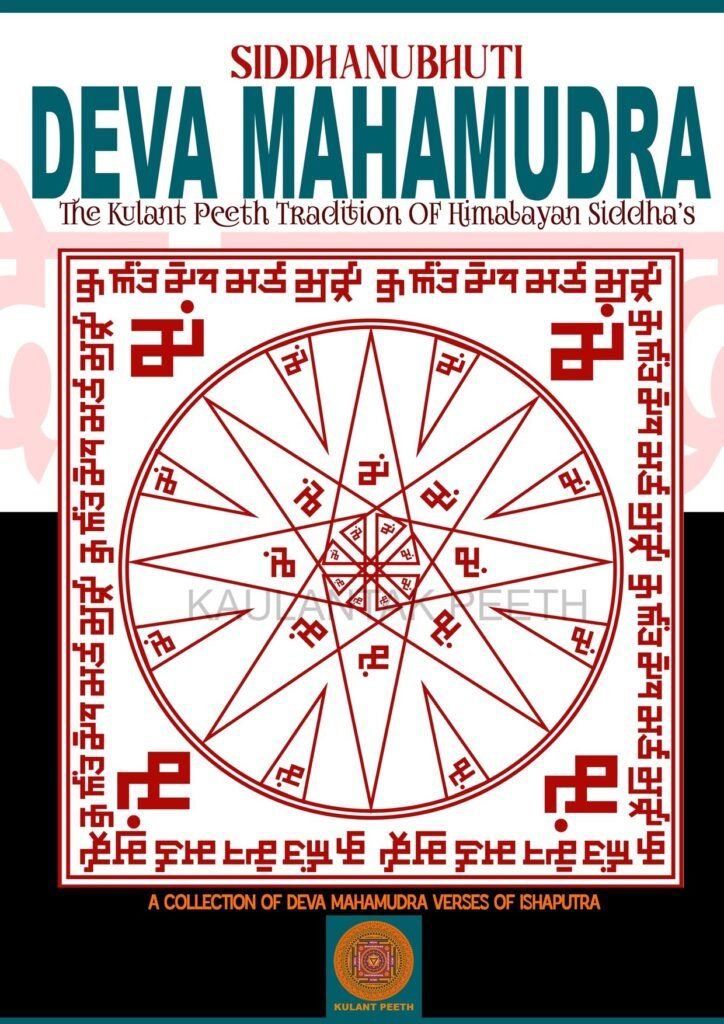Etymology
Mahamudra is a Sanskrit word, where ‘Deva’ means ‘Devata’, ‘Maha’ means great and ‘Mudra’ means a symbol or a seal which is embossed piece of wood, stone, metal, cloth etc. that is valuable and precious. For example ‘Swarna Mudra’ refers to a coin of gold. Deva Mahamudra’s objective is to tell that the whole universe is vast, miraculous and strange. The living beings here are also strange. We can’t understand ourselves. But there’s a state that exist through which we can understand ourselves and this universe. The question is how to attain that state? This wisdom was passed on by the ‘Devatas’ to the Siddhas. And that wisdom is represented by a symbol which involves sacred Geometrical symbols and is termed as Deva Mahamudra.
The Mahamudra originated from the Himalayan Siddha Dharma’s ‘Devayan Tradition’ (Deva Parampara). But later this term got very popular that it became an important representation of wisdom in Tantra, in Yoga Traditions and later many other religions adopted the fundamentals of ‘Mahamudra’ in their respective ways. In the Siddha Dharma’s Kulant Peeth Tradition, ‘Mahamudra’ symbolises the top, the essence of wisdom traditions of Siddha Dharma’s Devayan Tradition. There are many Mahamudras. The Deva Mahamudra is one of the twenty-one Divine, mysterious and top-most esoteric wisdom of the Siddha Dharma’s ‘Devayan Tradition’. It is the 11th number of the Mahamudra out of the 21 Mahamudras in the Himalayan Siddha Tradition.
Mahamudra is the extract, the deepest wisdom in any tradition. Since Kulant Peeth (or the Kaulantak Peeth) has many ‘Kulas’ (wisdom traditions) under it, the 11th number tradition is called as the Devayan Tradition of Siddha Dharm. The Deva Mahamudra is the highest wisdom and amalgamation of different types of practices around Mantra Practices, meditation Practices, Mandala Dhyan Practices, Yoga-Dhyan-Samadhi Practices along with the prayers and ‘Mahima’ (glory) of the Devi- Devatas and many more available from the Devayan Tradition of Siddha Dharma (also called as Deva Parampara). In Deva MahaMudra, the Mudra elaborate the experience of the Devatas. The experience of Devatas is completely different from the human experience. The Devatas understand the limitations of Human body and mind. That’s why the Devatas give this wisdom system and techniques through which humans can develop themselves to the ultimate levels, the state similar to the Devatas. And ‘Maha’ is the ultimate word. It denotes that nothing is beyond ‘Maha’. Here it represents that it is the ultimate, the most important, hidden wisdom system given by the Devatas for the most worthy Sadhaks in the Siddha Dharma’s Deva Parampara.
It is important to note that under Deva Mahamudra there is the ‘Sehaja Gyana Yoga’. According to Mahasiddha Bhed Nath, in tradition of Devi Kurukulla (Kulant Peeth Tradition), the practice of Deva Mahamudra enables the Sadhak to attain the ‘Shuddh Chitta Avastha’, that refers to the Purest state of mind.
History
It was the Kaulantak Nath, Mahasiddha Hemchandra Nath who was the very first Mahasiddha to receive the Deva Mahamudra the very first time in the history of Siddha Dharma. There are six main Devatas of Deva Mahamudra. They are Devraj Indra (King of Devatas),Deva Guru Brihaspati (the Guru of Devatas), Chadrama Devata (the holder of Amrit), Agni Devata (the fire God), Shesh Naga (the holder of whole universe) and Haryaksh Vyali (the protector of Mahamudra).
Since the beginning of Siddha Dharma (time unknown), in the history of Himalayan Siddhas the Deva Mahamudra involves ‘Hast Mudra’ (ritual hand gesture), the sacred Geometrical Deva Mahamudra seal, Yoga Mahamudra (a Mudra used in Yoga practice), Dhyan Mahamudra which is a specific technique of eye-ball movement during practice of Meditation, known as ‘Sarpini-Gati’, practice of ‘Shuddh Chitta Avastha’, ‘Ekatma Deva Bhava’ and the supreme attainment of ‘Devatva’.
In Siddha Dharma there are two main sacred texts on Deva Mahamudra along with the three great oral traditions. The two main texts are the ‘Deva Chakra Saar’ written by Mahasiddha Dakshesh Nath and the second is ‘Shuddha Bhumi Satva’. The ‘Shudder Bhumi Satva’ was written by female Mahasiddha Abhita Nath. According to ‘Maukhikh Parampara’ (Oral Tradition), Mahasiddha Sohan Nath attained the Deva Mahamudra near the Indrasan Parvat (Indrasan mountain) the very first time in history of Siddha Dharma in the land of Kulant Peeth.
In the tradition of Kulant Peeth, the Guru of the head of Kulant Peeth, that is the Kulant Nath, gives Him/ Her the Deva Mahamudra, and He/She experiences the Deva Mahamudra at that inexplicable, indescribable level. There is a rich and great lineage of Deva Mahamudra at the level of Sadhaks as the Kulant Nath (head of Kulant Peeth or the Kaulantak Peeth) are. For example the current Kaulantak Nath is the great Mahasiddha Ishaputra. When He received the Deva Mahamudra and experienced it, He said few things about it. What He has said about it is available in Hindi and English language for the seekers of the Deva Mahamudra.
The words of Kulant Naths are the essence, the drop of the ocean of the Deva Mahamudra wisdom in the Siddha Dharma tradition of the Himalayan Siddhas.
When the present Kulant Nath, Mahasiddha Ishaputra, received the knowledge and the ‘Shiksha- Diksha’ of the Deva Mahamudra from His Guru, He went to Indrasan Parvat, remembered the great Mahasiddha Sohan Nath, read the words written by Mahasiddha Sohan Nath about his experience after the completion of Deva Mahamudra, Mahasiddha Ishaputra then completed and experienced the Deva Mahamudra in August of 1998 before He became the Kulant Nath of Kulant Peeth. A manuscript of the booklet on Deva Mahamudra ‘Siddhanubhuti’ was written by Mahasiddha Ishaputra. Later it was compiled in form of a book.
Deva Mahamudra in Deva Parampara
In Kulant Peeth, Deva Parampara is followed which is completely different in itself. Here idol worshipping and the representative symbols like the ‘Rath’ (chariot) of a Devi-Devata is worshipped as that Devi-Devata themselves. This ‘Rath’ (vehicle of the Devi/ Devata) is considered as that particular Devi-Devata, and there is a ‘Goor’ or the ‘Ojha’ (Shaman) of that Devi-Devata. The Shaman of a particular Devi-Devata converse with that particular Devi-Devata. When the Shaman has to talk on extreme grave matters with the Devi or the Devata, then he goes to a Divine place in the Himalayan mountains. When the Shaman gets himself ready to talk with the Devi/ Devata amongst the mountains, then the impression of the hand (palm) is seen at the centre of his back. This impression of hand that is said to appear mysteriously and not much is ever revealed about the origin of the hand-impression, is considered as the simplified version of Deva Mahamudra. It is an extremely secretive practice of the Himachal Pradesh’s Kullu, Mandi, Saraj and few more regions in India, Himachal Pradesh. The practice that the Shaman will go to a sacred space in Himalayas, and will connect to the Divine Devi-Devatas, he will calm his ‘Chitta’ and become one with the Devi/ Devata, and then the impression of hand in red colour appears miraculously at the centre of the back of Shaman. Not much is revealed about this hand gesture on how it appears, if it is made by someone on the Shaman’s back.
But this is a popular practice as one of the sub-part of Deva Mahamudra. It is popular amongst the Ojha and Shamans of Deva Parampara.
Mahavidya and Deva Parampara
There are ten Mahavidyas (great wisdom/science) in Tantra. The Goddess Baglamukhi Mahavidya is related to the Deva Mahamudra because of Her ‘Stambhini’ Shakti. Baglamukhi is the female form of a personification of the Mahavidyas, a group of ten Tantrik deities in Hinduism. Goddess Bagalamukhi smashes the devotee’s misconceptions and delusions with her cudgel. The word ‘Bagala’ is derived from the word ‘Valga’ (meaning – bridle or to rein in) which, became ‘Vagla’ and then ‘Bagla’. Bagalamukhi is commonly known as Pitambari in North India, the Goddess associated with yellow color or golden color. She sits on golden throne having pillars decorated with various jewels and has three eyes, that symbolises that she can impart ultimate knowledge to the devotee.
Bagalamukhi is one of the ten forms of the Devi, symbolising potent female, primeval force. The ‘Tantrasara’, describes her iconography: Bagalamukhi sits in a golden throne in the midst of an ocean in an altar. Her complexion is yellow (golden). Clad in yellow clothes, she is adorned by a garland of yellow flowers and decked with yellow (golden) ornaments. She pulls the tongue of a demon by her left hand, while raising the right hand to strike him with a club.
Because the Goddess Bagalamukhi is the ‘Stambhini’ Shakti, so Deva Mahamudra involves six ‘swaroop’ (forms)of the Goddess.
- Smriti Stambhani
- Kalpana Stambhani
- Vichara Stambhini
- Nyay Stambhini
- Niyantran Stambhini
- Ashanti Stambhini




